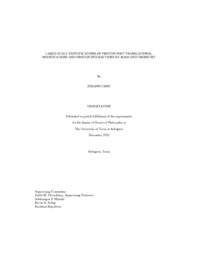
ATTENTION: The works hosted here are being migrated to a new repository that will consolidate resources, improve discoverability, and better show UTA's research impact on the global community. We will update authors as the migration progresses. Please see MavMatrix for more information.
Show simple item record
| dc.contributor.advisor | Chowdhury, Saiful M. | |
| dc.creator | Fang, Zixiang | |
| dc.date.accessioned | 2023-06-27T17:01:28Z | |
| dc.date.available | 2023-06-27T17:01:28Z | |
| dc.date.created | 2020-12 | |
| dc.date.issued | 2020-12-09 | |
| dc.date.submitted | December 2020 | |
| dc.identifier.uri | http://hdl.handle.net/10106/31309 | |
| dc.description.abstract | Biological organisms depend on proteins to carry out essentially all cellular activities and functions. Therefore, proteins are structurally complex to perform all the intricate cellular processes and functionally dynamic to adapt to the changing environments. Protein diversity and complexity are further contributed by the attachments of different post-translational modifications (PTMs) and complicated inter-molecular interacting networks, which are extremely challenging to study by traditional techniques. New-generation mass spectrometry (MS) has become a major driving force that drastically expand detection limits and improve capabilities to provide unprecedented information for protein molecular and structural determinations. My research focuses on developing MS-based proteomics strategies and utilizing the separative power of liquid chromatography (LC) for studying low-abundance protein PTMs and protein interactions in large-scale biological samples.
There are two major protein PTMs that I investigate during my PhD research: prenylation and proteolysis. Both prenylation and proteolysis are important for initiating and regulating protein functions and activities while having significant implications in pathogenic development of many diseases. To better identify the molecular constituents of these low-abundance but important protein modifications, I have been developing chemical and affinity approaches to target specific functional groups on these modifications for enrichment, as well as incorporating a gas-phase cleavable bond to prioritize the fragmentation and subsequent identifications of modification-containing peptides from complex cell lysate. The identification and enrichment study of prenylation are described in Chapter 2 and Chapter 3. The enrichment and identification strategy of protein proteolysis are introduced in Chapter 4. For the study of protein structures and interactions in Chapter 5, chemical cross-linking/MS strategy was applied to capture the potential interactive sites in proximity and improve the separation of cross-linked peptides by different column chemistries. We believe that these studies will facilitate the future proteomics research of protein PTMs and interactions. | |
| dc.format.mimetype | application/pdf | |
| dc.language.iso | en_US | |
| dc.subject | Mass spectrometry | |
| dc.subject | Proteomics | |
| dc.subject | Bioanalytical chemistry | |
| dc.title | LARGE-SCALE IDENTIFICATIONS OF PROTEIN POST-TRANSLATIONAL MODIFICATIONS AND PROTEIN INTERACTIONS BY MASS SPECTROMETRY | |
| dc.type | Thesis | |
| dc.date.updated | 2023-06-27T17:01:29Z | |
| thesis.degree.department | Chemistry and Biochemistry | |
| thesis.degree.grantor | The University of Texas at Arlington | |
| thesis.degree.level | Doctoral | |
| thesis.degree.name | Doctor of Philosophy in Chemistry | |
| dc.type.material | text | |
| dc.creator.orcid | 0000-0003-2307-3600 | |
Files in this item
- Name:
- FANG-DISSERTATION-2020.pdf
- Size:
- 4.038Mb
- Format:
- PDF
- Name:
- LARGE-SCALE IDENTIFICATIONS OF ...
- Size:
- 6.591Mb
- Format:
- Microsoft Word 2007
This item appears in the following Collection(s)
Show simple item record


